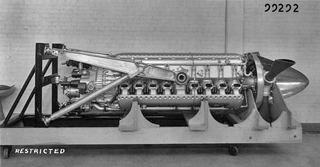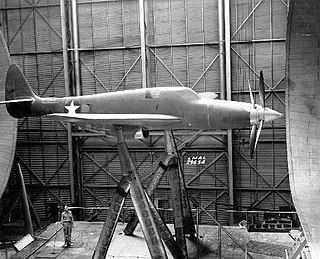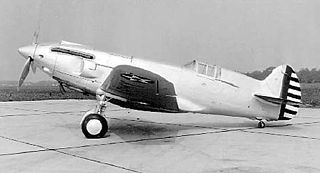
The hyper engine was a 1930s study project by the United States Army Air Corps (USAAC) to develop a high-performance aircraft engine that would be equal to or better than the aircraft and engines then under development in Europe. The project goal was to produce an engine that was capable of delivering 1 hp/in3 (46 kW/L) of engine displacement for a weight of less than 1 lb/hp delivered. The ultimate design goal was an increased power-to-weight ratio suitable for long-range airliners and bombers.

The Pratt & Whitney R-1340 Wasp is an aircraft engine of the reciprocating type that was widely used in American aircraft from the 1920s onward. It was the Pratt & Whitney aircraft company's first engine, and the first of the famed Wasp series. It was a single-row, nine-cylinder, air-cooled, radial design, and displaced 1,344 cubic inches (22 L); bore and stroke were both 5.75 in (146 mm). A total of 34,966 engines were produced.

The Curtiss SOC Seagull was an American single-engined scout observation seaplane, designed by Alexander Solla of the Curtiss-Wright Corporation for the United States Navy. The aircraft served on battleships and cruisers in a seaplane configuration, being launched by catapult and recovered from a sea landing. The wings folded back against the fuselage for storage aboard ship. When based ashore or on carriers the single float was replaced by fixed wheeled landing gear.

The Bell XP-77 development was initiated by the United States Army Air Forces during World War II to produce a simplified "lightweight" fighter aircraft using non-strategic materials. Despite being innovative, the diminutive prototype proved tricky to handle and the project was canceled when the XP-77 did not deliver its projected performance.

The Curtiss P-60 was a 1940s American single-engine single-seat, low-wing monoplane fighter aircraft developed by the Curtiss-Wright company as a successor to their P-40. It went through a lengthy series of prototype versions, eventually evolving into a design that bore little resemblance to the P-40. None of these versions reached production.

The Chrysler XIV-2220 was an experimental 2,500 hp, 2,220 cubic inch liquid-cooled inverted-V-16 World War II aircraft engine. Although several aircraft designs had considered using it, by the time it was ready for use in 1945 the war was already over. Only a few engines were built by Chrysler during a program that started in 1940, and it retained its 'X' designation the entire time as the XIV-2220, later XI-2220. The IV-2220 is historically important as it was Chrysler's first hemi, a design that would re-appear in late-1950’s Chrysler luxury performance automobiles, make drag racing headlines in the 1960s, and continue into the 2000s.

The Republic XP-69 was an American fighter aircraft proposed by Republic Aviation in 1941 in response to a requirement by the United States Army Air Corps for a high-speed fighter. Manufacturers were encouraged to consider unorthodox designs; although the design was ordered as a prototype it was canceled because of delays with the engine that was to power it.

The Curtiss P-6 Hawk is an American single-engine biplane fighter introduced into service in the late 1920s with the United States Army Air Corps and operated until the late 1930s prior to the outbreak of World War II.

The P-1 Hawk was a 1920s open-cockpit biplane fighter aircraft of the United States Army Air Corps. An earlier variant of the same aircraft had been designated PW-8 prior to 1925.

The Douglas XP-48 was a small, lightweight fighter aircraft, designed by Douglas Aircraft in 1939 for evaluation by the U.S. Army Air Corps. Intended to be powered by a small inline piston engine, the contract was cancelled before a prototype could be constructed, due to the Army's concerns about the projected performance of the aircraft.

The Curtiss SO3C Seamew was developed by the Curtiss-Wright Corporation as a replacement for the SOC Seagull as the United States Navy's standard floatplane scout. Curtiss named the SO3C the Seamew but in 1941 the US Navy began calling it by the name Seagull, the same name as the aircraft it replaced, causing some confusion. The British Royal Navy kept the Curtiss name, Seamew, for the SO3Cs that they ordered. One of the US Navy's main design requirements was that the SOC Seagull's replacement had to be able to operate both from ocean vessels with a single center float and from land bases with the float replaced by a wheeled landing gear.

The Curtiss F6C Hawk was a late 1920s American naval biplane fighter aircraft. It was part of the long line of Curtiss Hawk airplanes built by the Curtiss Aeroplane and Motor Company for the American military.

The Bellanca 28-92 Trimotor was a racing aircraft built to compete in the Istres-Damascus-Paris Air Race of 1937, and was paid for by popular subscription in Romania. Christened Alba Julia it was piloted by Captain Alexander Papana of the Romanian Air Force.

The Fairchild AT-21 was an American World War II specialized bomber crew trainer, intended to train crews in the use of power gun turrets or a gun on a flexible mount, as well as learn to function as a member of a crew. It had a brief career as a training aircraft before modified bombers took over this role.

The Edo OSE was a 1940s American single-seat multi-role floatplane designed and manufactured by the Edo Aircraft Corporation.

The Curtiss P-37 was an American fighter aircraft made by Curtiss-Wright in 1937 for the US Army Air Corps. A development of the Curtiss P-36 Hawk to use an inline engine instead of the radial engine of the P-36 the fuselage was lengthened and the cockpit moved back. A small number of YP-37 aircraft was built for Air Corps evaluation. The expected top speed was not achieved and the project terminated in favor of the Curtiss P-40.

The Vought XSO2U was an American observation floatplane developed by Vought-Sikorsky for the United States Navy during the late 1930s. Intended to replace the Curtiss SOC Seagull in service as a scout aboard cruisers, it proved superior to the Curtiss SO3C in evaluation, but failed to win a production contract due to Vought's lack of manufacturing capacity.
The Ikarus 215 twin-engine plane, was a Yugoslav light bomber and a training aircraft of mixed construction, the prototype flew in 1949. It did not go into production. The prototype was used for training and as a liaison. It was designed and built at the Ikarus factory in Zemun-Belgrade.



















